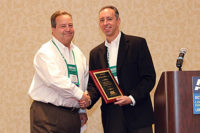A leader’s ability to recognize each of his or her staff member’s capabilities, whether behavioral or technical, is the key to the success and effectiveness of any functional or cross-functional team.
Often, superior employees are lost to competitive career opportunities simply because leaders make the mistake of managing all employees with the same leadership style.
As leaders, we fall short of our intended aims and objectives when we simply rely on job descriptions, group meetings and formal incentive programs to maintain a healthy work environment, and a satisfied and motivated workforce.
In order to succeed in today’s work environment, leaders must know how to maximize their efficiency by maintaining good communication channels, strengthening their ability to work as a team, and motivating their staff to feel a personal sense of ownership and accountability for their individual roles and responsibilities.
Following is a case study of a small organization that solicited the assistance of a behavioral and leadership-development consulting firm to address these issues:
- From a behavioral perspective, assess the dynamics of the work group to determine individual needs and areas for improvement;
- From a strategic perspective, measure current levels of performance and process effectiveness;
- From a tactical perspective, recommend improvement suggestions and provide feedback and coaching to implement the learned skill sets.
This group felt that someone who was aware of current business concepts and had the ability to assess the behavioral environment and the group’s readiness for change would add tremendous value in helping the team meet its objectives.
Following is a summary of the project.
Client:
A major supplier of DuPont products.Objective:
Help foster effective teamwork, leadership and communication skills among the senior-leadership team, and then between levels and within functional and cross-functional teams, utilizing as a foundation the Myers-Briggs Type Indicator and other behavioral and process-improvement dynamics.Method:
- Interview senior-leadership team for baseline assessment of current levels of effective communication, collaboration, teamwork and leadership capabilities;
- Administer the Myers-Briggs Type Indicator;
- Conduct an awareness session to review results and provide education;
- Observe leadership effectiveness during scheduled team meetings, and provide one-on-one feedback to reinforce the implementation/integration phase of the training and development effort; and
- Meet with staff members to distribute Myers-Briggs Type Indicators, and explain the purpose and use of the instrument to enhance the existing behavioral environment;
- Conduct a half-day awareness session to review results and help the entire team adopt better teamwork, communication and leadership capabilities, regardless of position or responsibilities; and
- Revisit with group to benchmark progress.
By Chance ...
The senior-management team consisting of five executives appeared, at first, to have effective communication skills and the ability to work cohesively toward common goals. However, the dynamics of the team quickly illustrated a lack of communication on certain issues. There was a marked deference to the CEO and greater comfort in “going with the flow” or withdrawing during a meeting and resorting to post-meeting sidebar discussions that excluded participation and decision-making by all team members.When one of the team members would attempt to introduce new concepts (i.e., new incentive programs, process-improvement suggestions, etc.) the team would not allow the time needed for that individual to fully express himself or herself. In addition, the individuals communicating the information were not assertive in asking for the “floor” to get across their valuable points.
There were also many emotional “swings” where individuals, who felt their position challenged, would resort to bouts of frustration, exhibiting ineffective communication styles. This created a chaotic environment where agenda items were ignored and spontaneous topics and discussions dominated the time allotted.
The meetings were not effective, and they wasted valuable time. Often, the meetings did not fully address many critical issues. On the occasion where issues were addressed in the meeting, they were later subject to second-guessing by members of the team.
This created a mixed-signal approach when disseminating information to the rest of the organization, causing apathy among staff members, who otherwise were very committed and desperately seeking direction from their leadership team.
By Choice ...
Once the above baseline assessment was documented, each individual on the executive team was given the Myers-Briggs Type Indicator to complete. A mini-session was conducted to present results. The results are stated in the table. Please note that the four-letter indicators represent a hypothesis of the person’s innate behavioral style, based on the results of the Myers-Briggs Type Indicator.Personality typing is most useful in pointing individuals in a particular direction. They can then take the information and adapt it based on existing skills and life experiences in order to maximize efficiency levels. In combination with personalized interviews and process assessments, it adds another dimension of understanding for a leader to work from his or her position of strength.
With the results shown in the table (offered herein in a very abbreviated format for discussion purposes), the consultant was able to identify natural work patterns and the way these patterns enhanced or inhibited the team’s ability to be effective.
It had become second nature for the CEO and director of sales to meet off-line and work independently on projects, sometimes at the exclusion of the sales staff and other members of their executive team. Until the assessment and feedback sessions were conducted, they were unaware of how their natural work styles impacted the rest of the team.
The CFO and president also found it easier to work together since they shared the same vision of introducing change and innovation in the organization. However, it took some time for the CFO to speak his mind fully, stay on task and not fall prey to leaving things open-ended. Both president and CFO had to learn to stay on-task and prioritize. They had to learn to delegate, trust, mentor and coach instead of “doing” the work for their staff. They also realized that their quest for “perfection” prevented them from completing projects on a timely basis.
Finally, the controller, responsible for receivables and payables, had the most difficult role of all . . . that of keeping sales informed of delinquent accounts, holding up orders that were about to be shipped because of overdue balances, and contacting long-standing clients to politely collect funds due before “shipments as usual” could continue.
The controller was very effective in “getting the job done.” However, the controller was not remiss in telling anyone in the organization how he or she could do their job better. The controller also had a “gift” for identifying things that didn’t go well, which in many cases is necessary. But when the information is delivered in a manner that undermines the team members’ sense of trust and empowerment, it counteracts what the group is striving to achieve.
Effective Leadership in Action
The CEO and director of sales learned the importance of sharing their information with others in the organization; filtering information down the ranks; including their sales representatives in important meetings, lunches and phone conferences; and valuing the skills of other personality styles in the group to prevent “blind spots” and make better task-driven and people-driven decisions.Although these two individuals were master communicators with their external clients, they had to learn to use the same approach with their internal customers and suppliers so that they could motivate their valued staff to higher achievement.
The senior-leadership team members eventually became acquainted with the personality types of all of their staff members. The facilitators taught them how to communicate with different types, motivate each of these types and be more effective leaders. This same group of people now perceives itself as a positive, functional team. It is more willing to share ideas, participate in decision-making and provide feedback for continual improvement.
The CEO and sales director have reported much better outcomes since their participation in the training effort and follow-up coaching. They are communicating better with external clients, and are supporting their internal customers and suppliers in a much more effective manner. Clients are now aware that every person in the organization has the power to report findings and take action to ensure client satisfaction.
The president of the company has learned the importance of not only sharing her ideas conceptually but also communicating her vision and sense of innovation and creativity in a more practical manner. This enables her to relate more effectively to the different types within the organization that must understand the practical implication of suggestions for improvement. In the past, the president would bring open-ended concepts to the CEO, only to find that the CEO would become overwhelmed, would lose confidence and deduce that the ideas were not fully conceptualized and, therefore, would not work.
The president now goes through the proper questioning for effective problem solving before any ideas are presented to the CEO or others in the organization. The concepts are formalized with the reason for the idea, the value-added components, impact on resources and profits, benefit to the client, duration of the project, and the project’s enhanced outcomes. This is an extreme departure from the past where ideas were presented conceptually and left to interpretation by senior management and staff.
Team meetings are now scheduled and supported by an agenda that is circulated in advance. Tasks are properly delegated and assigned to the team member that best fits the skill set required to accomplish them. Timelines are reviewed and agreed upon by the group.
An example of the new level of collaboration was witnessed in the improved hiring process. Key staff members are now part of the hiring committee and conduct the initial round of interviews, with second interviews conducted by the respective leader. The hiring process was enhanced to include a series of service-related as well as technical interview questions to ensure that candidates desire a healthy work environment and a spirit of collaboration and teamwork. Additionally, the Myers-Briggs Indicator is administered to all new hires, and feedback is provided during the employee-orientation program.
In Summary
Followed over a six-month period, everyone in the organization now reports a more enriching daily-work experience. They perceive a true sense of commitment, competency and willing desire to contribute to day-to-day successes. There is a deliberate emphasis on the importance of honest and open communication throughout the organization. New hires report that the roles and responsibilities initially explained in the hiring process match the hands-on experiences associated with their actual job function. Members within and between departments are willing to help each other. Initial and cross-functional training is a natural part of the process. The senior-leadership team is more accessible, approachable, and open to input and feedback. A true empowered environment is emerging with energized, motivated individuals that understand their responsibilities in the organization as well as the role played by senior management. The end result is a happier staff, a motivated work environment, people extending extra effort, decisions based on input from all members of the organization and higher profits. All this is driven by the organization’s understanding of its people and the contributions their diverse work styles bring to improve procedures.Ann Marie Witt, president of Human Insights Consulting, Inc., is a professional development consultant and board-certified hypnotherapist. With over 20 years experience in the field of organizational development and human behavior, she is dedicated to meeting the needs of professionals at all levels in an organization. For further information on the programs and services available, including TopTHINK Strategic Leadership Challenges, contact Ann Marie Witt at 910-483-1209 or witthi@aol.com

